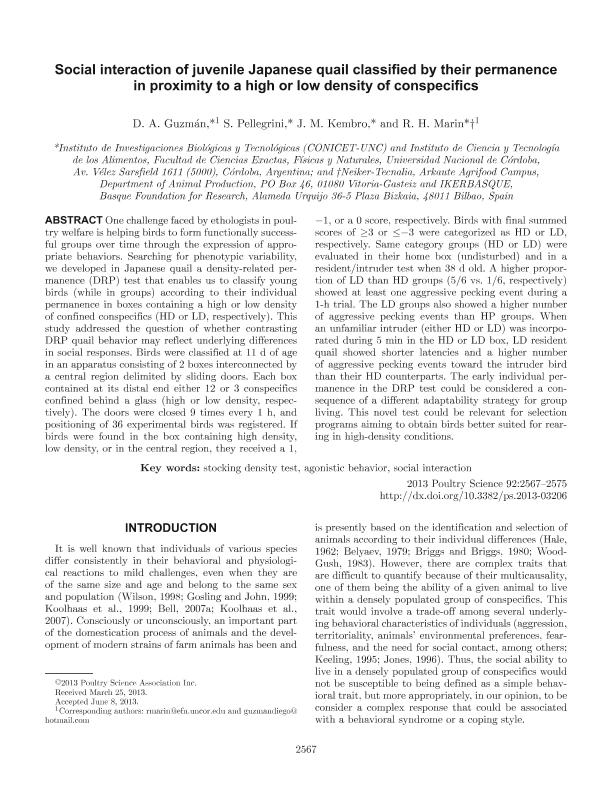Artículo
Social interaction of juvenile Japanese quail classified by their permanence in proximity to a high or low density of conspecifics
Fecha de publicación:
10/2013
Editorial:
Poultry Science Association
Revista:
Poultry Science
ISSN:
0032-5791
e-ISSN:
1525-3171
Idioma:
Inglés
Tipo de recurso:
Artículo publicado
Clasificación temática:
Resumen
One challenge faced by ethologists in poultry welfare is helping birds to form functionally successful groups over time through the expression of appropriate behaviors. Searching for phenotypic variability, we developed in Japanese quail a density-related permanence (DRP) test that enables us to classify young birds (while in groups) according to their individual permanence in boxes containing a high or low density of confined conspecifics (HD or LD, respectively). This study addressed the question of whether contrasting DRP quail behavior may reflect underlying differences in social responses. Birds were classified at 11 d of age in an apparatus consisting of 2 boxes interconnected by a central region delimited by sliding doors. Each box contained at its distal end either 12 or 3 conspecifics confined behind a glass (high or low density, respectively). The doors were closed 9 times every 1 h, and positioning of 36 experimental birds was registered. If birds were found in the box containing high density, low density, or in the central region, they received a 1, -1, or a 0 score, respectively. Birds with final summed scores of ≥3 or ≤-3 were categorized as HD or LD, respectively. Same category groups (HD or LD) were evaluated in their home box (undisturbed) and in a resident/intruder test when 38 d old. A higher proportion of LD than HD groups (5/6 vs. 1/6, respectively) showed at least one aggressive pecking event during a 1-h trial. The LD groups also showed a higher number of aggressive pecking events than HP groups. When an unfamiliar intruder (either HD or LD) was incorporated during 5 min in the HD or LD box, LD resident quail showed shorter latencies and a higher number of aggressive pecking events toward the intruder bird than their HD counterparts. The early individual permanence in the DRP test could be considered a consequence of a different adaptability strategy for group living. This novel test could be relevant for selection programs aiming to obtain birds better suited for rearing in high-density conditions.
Palabras clave:
Agonistic Behavior
,
Social Interaction
,
Stocking Density Test
Archivos asociados
Licencia
Identificadores
Colecciones
Articulos(IIBYT)
Articulos de INSTITUTO DE INVESTIGACIONES BIOLOGICAS Y TECNOLOGICAS
Articulos de INSTITUTO DE INVESTIGACIONES BIOLOGICAS Y TECNOLOGICAS
Citación
Guzmán, Diego Alberto; Pellegrini, Stefanía; Kembro, Jackelyn Melissa; Marin, Raul Hector; Social interaction of juvenile Japanese quail classified by their permanence in proximity to a high or low density of conspecifics; Poultry Science Association; Poultry Science; 92; 10; 10-2013; 2567-2575
Compartir
Altmétricas




